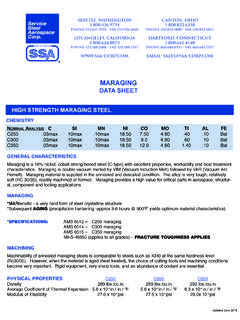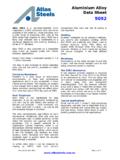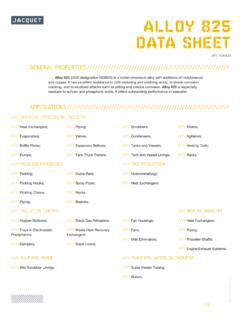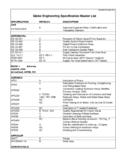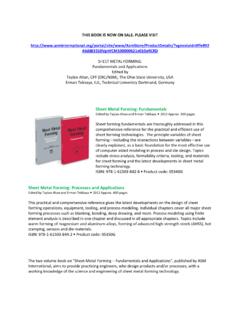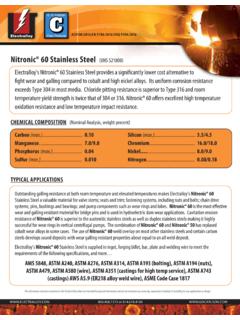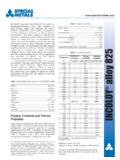Transcription of SPEC DATA SHEET SEALANTS 33S SILICONE
1 PRODUCT NAME CRL 33S SiliconeOne-Component SILICONE Elastomeric DESCRIPTION CRL 33S SILICONE is a one-component room temperature curingsilicone elastomer. 33S SILICONE is a proven construction sealantwith various field applications in place that continue to perform and meet building 33S SILICONE complies with the following FederalSpecifications: TT-S-001543A (COM-NBS) Class A, Federal Specification forSilicone Building SEALANTS TT-S-00230C (COM-NBS) Class A, Non-Sag FederalSpecification for One-Component SEALANTS ASTM C920 Standard Specification for Elastomeric JointSealant as Type S, Grade NS, Class 25, Use NT, G, and A Canadian Government Specification BoardBASIC USESCRL 33S SILICONE is especially designed for joining and sealinga variety of structural materials (glass, aluminum, metal alloys,and many plastics).
2 It will seal curtainwall joints, multi-panewindows, steel windows, aluminum windows, glass partitionsand skylights. Indoor uses include sealing around bathtubs,showers and sanitary installations (clear, white, translucentwhite and tan colors contain an additive that makes the curedsilicone resistant to mildew). CRL 33S SILICONE in all colorsmeets the requirements of FDA regulation for use in food-related applications such aswalk-in freezers, refrigerated trucks, 33S is authorized by the United States Department ofAgriculture for use in federally inspected meat and poultryplants, and has been classified as by NSF to Standard 51-Plastic Materials andComponents used in Food 33S SILICONE is a UL Recognized Component.
3 LIMITATIONSCRL 33S is not recommended for: Use as structural SILICONE , or insulating glass glazing. Concrete and stone expansion joints, horizontal decks, patios,driveway or terrace joints where abrasion or physical abuseis encountered. Sealing submerged joints, particularly where porous surfacespermit water infiltration to the bond surface. Interior or exterior structural sealing below the waterline inmarine applications. Designs that will be painted after application of the films bridge the sealant but do not adhere to thesealant. Tooling techniques using solvents or detergent soap solutionsare not recommended.
4 CRL 33S SILICONE should not be applied in applicationswhere appearance is critical without conducting a test todetermine its compatibility and migration to the LIMITATIONSCRL 33S Sealant should not be applied to the following surfaces: Not recommended for surfaces with special protective orcosmetic coatings without prior consultation of themanufacturer. Such surfaces include, but are not limited to,mirrors, reflective glass, surfaces coated with teflon,polyethylene or polypropylene where delamination is possible. Construction materials that may exude oils, resins,plasticizers or include, but are not limited to,unfinished or impregnated woods, certain rubber or plasticgaskets and tapes, and failed non- SILICONE SEALANTS or caulkingcompounds.
5 Concrete, marble, limestone, lead or lead-coated surfaces, andcopper are not acceptable substrates for CRL 33S SILICONE . Unclean or wet DATAThe physical properties of CRL 33S SILICONE are shown inTa ble LAURENCE CO., INC. CORPORATE HEADQUARTERS: POST OFFICE BOX 58923, LOS ANGELES, CA 90058-0923 TOLL FREE TELEPHONE (800) 421-6144 TOLL FREE FAX (800) 262-3299E-MAIL: WEBSITE: SEALANTSSPEC data SHEETAUGUST 2002(Supersedes September 2000)SEALANTS33S SILICONE 7 PROFESSIONAL QUALITYAUGUST 2002(Supersedes September 2000)PROFESSIONAL QUALITYSEALANTS33S SILICONE 7 PAGE 1 OF 4 33S SILICONEAVD3106 REV 11/02 TABLE 1 - PHYSICAL PROPERTIESP roperty/Test MethodsValueShore A (Hardness) ASTM D-2240.
6 25 Tensile Strength, ASTM D-412 .. 350 psiLap Shear at 1/8" Thickness ..120 psiTear Strength ..25 ppiElongation at Ultimate Break, ASTM D-412 .. 500%Elasticity Modulus at 100% psi, ASTM D-412 ..75 psiConsistency .. Non-FlowingSpecific Gravity at 77 F (25 C) .. Time .. Varies with Temperature/RHTack Free Time ASTM C-679 .. 20 MinutesCuring Time .. 2 Days(1/4" Bead @77 F (25 C)/50% Relative Humidity)Flow; Sag or Slump, ASTM C-639 .. NilUV Resistance, ASTM C-793 .. ExcellentService Temperature ..-80 F (-62 C) to 400 F (204 C) LAURENCE CO., INC. CORPORATE HEADQUARTERS: POST OFFICE BOX 58923, LOS ANGELES, CA 90058-0923 TOLL FREE TELEPHONE (800) 421-6144 TOLL FREE FAX (800) 262-3299E-MAIL: WEBSITE: PRINCIPLES OF JOINT DESIGNF igure 1 illustrates why a thin bead of SILICONE sealant willaccommodate more movement than a thick bead.
7 Obviously,the thin bead is the most DIMENSIONSJ oint width should be four times anticipated movement, but atleast 1/4" wide. Maximum joint movement should not exceed25% applicable to both horizontal and vertical joints. CRL 33 Sgenerally follows standard ASTM Specifications (2 to 1, width to depth ratio), when used at widths of 1/4" or CRL 33S SILICONE requires standard cleaning procedures priorto sealant application. Clean all joints and glazing area byremoval of foreign matter and contaminants such as oil, dust,grease, frost, water, surface dirt, old SEALANTS or glazing compounds, as well as any protective coatings.
8 Porous substrates should be cleaned where necessary by grinding, sawcutting, blast cleaning (sand or water), mechanical abrading ora combination of these methods which will be required to provide a sound, clean and dry surface for sealant , glass and plastic surfaces should be cleaned by a solventprocedure or by mechanical means. Detergent or soap andwater cleaning treatments are not recommended. Protectivefilms must be removed by a solvent recommended by the manufacturer of the component or other means which leaveno residue. In all cases where used, solvents shall be appliedwith one clean cloth or lint-free paper towel, and then wipedclean with a second cloth or towel.
9 Cleaning solvents shouldnot be allowed to air dry or evaporate without coatings, paints and plastics shall be cleaned witha solvent approved by the manufacturer of that of all surfaces should be done on the same day inwhich sealant is adjacent to joints should be masked to assure neatsealant lines. Do not allow masking tape to touch the clean surfaces to which the SILICONE is to should becompleted in one continuous stroke immediately after sealantapplication and before a skin forms. Masking should beremoved immediately after bead of SILICONE sealant applied to the material surface at thejob site or manufacturing location to test adhesion prior togeneral job use is always recommended.
10 Primers are requiredfor some surfaces. See Table 2 for primer must be applied according to manufacturer's printedinstructions. Priming is not usually required on glass, standardaluminum finishes and most Install backup material or joint filler, setting blocks, spacer shims and tapes as specified. Apply CRL 33S SILICONE with hand gun or pressure equipment according to FGMA standards in a continuous operation using a positive pressure adequate to properly fill and seal the or strike the sealant with light pressure to spread the material against the backup material and the joint surfaces.


